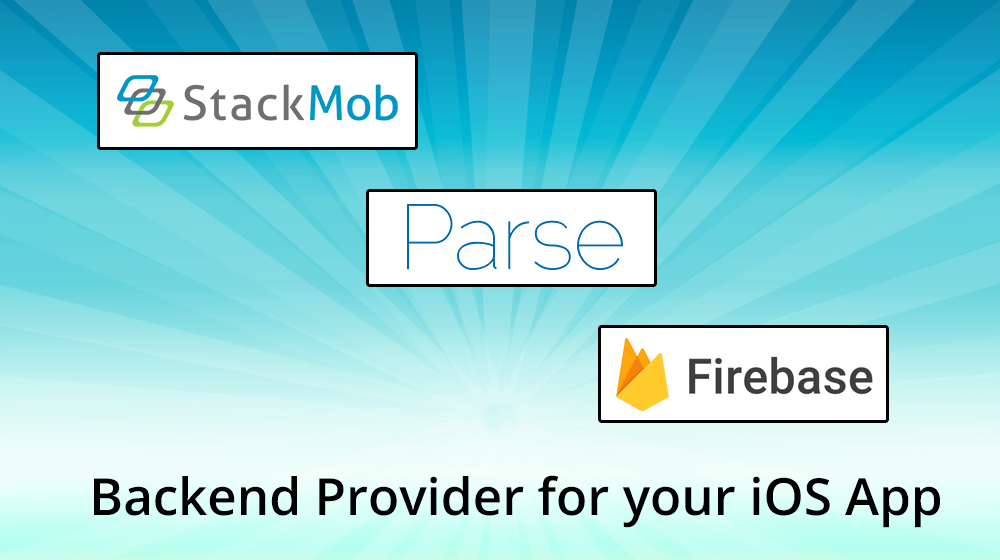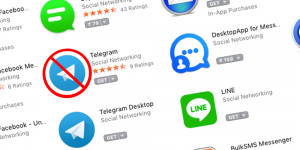
Web backend is the need of every apps and cannot be avoided. It gives you the access of having a central database with the help of which it becomes easy for the users to share their content with each other including Photos, messages or reviews of the restaurants. In older days, it was possible for us to develop all this on our own as we have existence of certain technologies like Ruby on Rails or PHP. But things do change with the time and it did here as well. There are certain challenges being faced which are as follows:
It demands huge time investment as the development of backend takes a lot of time.
Being a skilled front end iOS app developer will not make you skilled in back end development too. Both of it are different aspects and demands time to learn.
We never can identify or understand the exact nature of iOS apps and App store as we do are not sure if app usability will be limited or it is going to be huge with millions of users. Measuring the Scalability while developing the back end is a difficult task to be done.
To make it easy for you and sort all your problems, now there are many app development firms who aids in the development of back end and offers you with a premade and highly configurable web backends that can be easily integrated with your apps. These are quite popular as Backend service or BaaS.
What exactly is a Backend-as-a-Service?
Backend-as-a-Service, often known as BaaS, is a cloud service paradigm that allows developers to outsource all of the behind-the-scenes aspects of a web or mobile application. This leaves the developers with the responsibility of simply writing and maintaining the front end of the application.
BaaS vendors offer pre-written software for activities that occur on servers, such as user authentication, database management, remote updating, and push notifications (for mobile apps), in addition to cloud storage and hosting services. These activities include managing databases, remotely updating software, and updating mobile apps.
What exactly is meant by “Mobile-Backend-as-a-Service?”
BaaS stands for backend as a service, and Mobile-Backend-as-a-Service (MBaaS) is a type of BaaS designed exclusively for the construction of mobile applications. Although some sources consider BaaS and MBaaS to be essentially interchangeable concepts, it is not necessary to employ BaaS services in order to create mobile applications. BaaS services may also be used for other purposes.
What You Need To Know Before Deciding On An iOS App Backend Provider?
To come up with the best course of action, you’ll need to narrow down your list. There are a lot of factors that you may need to consider in order to choose the best backend provider for your iOS app.
Here we have compiled a list of most important factors that you need to consider while choosing BaaS service provider. Take a look…
1. Level of app development
An MVP (Minimum Viable Product) is a minimum viable app that demonstrates that your target audience wants your product. Because of the urgency with which it must be released, it probably lacks even the most fundamental of the characteristics you assume your target audience will find useful.
Or is it more important that the app be built with enterprise-grade architecture from the start, fit for a major corporation?
For this to be successful, you’ll need a solution that can grow with your needs and is enjoyable to work with over time.
If you’re trying to release a minimum viable product, a basic, easy, and affordable backend that will just get the job done is the best backend for your iOS app. It ought to be something that your target demographic can try very quickly to determine if it meets their requirements.
While writing the Swift or Objective-C code that will connect with the server, you should also make sure that the API communication is at a suitable degree of abstraction.
If you set up your system in such a way, switching to a new provider in the future won’t be a big hassle, and your customers won’t experience any downtime.
2. Data storage
When working with relational data, for example, a SQL database is ideal. On the other hand, a document-oriented database may be more suitable for some uses. You should think about whether or not you need to aggregate your data or develop filters before you can merge it.
There are several inexpensive cloud storage alternatives that are tailored toward storing simple documents.
3. User Interface
While looking for an iOS app developer, you must consider user interface. You must opt for a user-focused design to determine what information your users require. For that, you need to determine the best method of storing that information. Know that the user interface is the first and last thing that users will see, so make sure it looks good. The easiest way is to begin by constructing the app’s user interface, then working your way backward.
4. Consider your requirements
While selecting a backend system you must consider your requirements. Before you begin developing any code, whether it’s for the backend or iOS, you need to take into account a set of factors that could determine the success or failure of your iOS application. These factors could include the following:
- Time Commitment: It is crucial to determine how much time do you and your team anticipate it will take to build a whole new backend server from the ground up.
- Expertise: Expertise matters, especially when you do not lack the required knowledge. You’ll need to ask yourself – Do you have any knowledge of server programming languages? REST application programming interfaces (APIs) are typically created for new businesses using Node.js or Ruby on Rails. Do you possess such a level of expertise in your toolkit of skills? You will also need to architect the client-server communication, which calls for a new set of skills than the previous tasks. If you lack the required knowledge, then surely finding a reputable backend service provider is the only option you have.
- Performance: Of course, performance is one of the most important aspects that will determine the success or failure of your iOS application. You need to have a bespoke web backend.
When using a service provider, the majority of the computing work is performed on the iPhones of the users. If your application has a lot of work to perform (pre-computations, heavy computing, etc.), it may be a good idea to do it server-side and spare your users a lot of resources. This is because server-side processing can be done much faster than client-side processing (battery, network, data, disc space, etc.).
Thankfully, the majority of iOS apps have relatively low-performance requirements, with the majority of the computational effort ultimately consisting of straightforward CRUD processes.
- Scalability: You need to have a scalable backend. Not only will it simply cost money, but it will also save you a lot of time and effort, and it will be a surefire success.
- Budget: If you are unable to plan and construct a server on your own, you will be required to make an investment of some sort right from the start. Backend providers grant permission to app owners to run their iOS applications without charging up to a predetermined traffic threshold. This is a fantastic method for testing out a minimum viable product (MVP) without having to invest any money in backend resources.
Possible Courses of Action
Once you have figured out all the above factors, you may begin exploring your possibilities. If your app requires backend assistance, you must determine which solution is most suitable for your user base.
Top 12 Features of Backend-as-a-Service
There are a few things you need to think about right off the bat in order to select the optimal backend for your iOS application. A variety of server-side features are made available by BaaS providers.
Here are some of the features that you should look for in order to select the best backend provider for your iOS app:
1. Data Administration
It is important to note that most users today utilize applications on numerous devices and would want to have a centralized location where all of their app data, data sets, and profiles are stored and managed.
However, keeping the permanent data on a reliable backend server is the optimal approach for management purposes.
As a result of strong virtual computers, analyzing, filtering, and combining the data becomes a cakewalk.
Secure and encrypted data connection, permanent storage, and client synchronization are just some of the benefits that Mobile Backend may offer as a Service in exchange for a more user-friendly client application.
2. User Authentication
Security is one of your most pressing concerns today. It is because most mobile applications are hosted on the internet. User authentication is a part of the BaaS login functionalities.
Any time end users access an external application server, the service provider must take extra precautions to ensure the identity of those using the server. However, alternative mBaaS options manage all user authentication options for apps more effectively, making them the best option when determining how to implement the feature.
You no longer need to worry about whether or not the user authentication mechanism is functioning properly.
3. Two-Step Verification Process
Optimal two-factor authentication implementation has historically been difficult to achieve with relative ease.
Two-factor authentication is one of the most crucial security features that can guarantee the safety of apps more effectively. A reputable BaaS provider will provide two-factor authentication for all users and all applications.
4. Real-time database
NoSQL cloud-hosted databases are increasingly used as the real-time databases of mobile applications because of their ability to enable users to save and sync data in real time. Furthermore, this BaaS function can facilitate optimal cross-device collaboration.
Real-time databases make real-time syncing a breeze. It allows users to obtain the data they need from any device, be it a mobile phone or a web browser.
5. Social Cohesion
The majority of mBaaS solutions already include tools for managing users. Consequently, it is crucial to evaluate the integration of social media platforms. These BaaS features make it easier for users to log in to third-party applications and access their data.
6. Cloud-Based Software
Cloud-based functions can be triggered by events in other services, such as the creation of a new user, the completion of a purchase, a change in the findings of an analysis, and so on.
However, BaaS only requires a couple of simple commands to deploy the code to the servers, and then cloud functions can automatically scale up the computing resources to fit the application’s user patterns.
There will be no need to deal with issues like server configuration, SSH credentials, or the deployment of new servers with the shutdown of existing ones.
7. “Push” Notifications
It’s hard to work with different mobile apps that have different user interfaces for client notifications. However, this problem can be solved with the help of Mobile Backend as a Service. It provides a centralized queue of alerts that sits between mobile client subscribers and backend notification publishers.
By providing straightforward application programming interfaces (APIs), mBaaS makes it possible for backend applications to broadcast messages to any client or specific device that has subscribed to a given SNS (Simple Notification Service). As a result, applications may be able to get alerts from a wider variety of providers.
8. Email Verification
Implementing email verification when a person registers using an email address is crucial. This will guarantee the highest level of service and security.
Many BaaS solutions already provide free email verification services for developers. You don’t need to spend a fortune to take advantage of this useful tool.
9. REST Application Programming Interface
BaaS has many appealing features that can aid developers in meeting the backend needs of online and mobile apps. Using the REST API and software development kits (SDKs), these services can turn any kind of logic, programmed or not, into an API.
The REST service endpoints of your API will be more readily visible using this. In addition, these services will make it easier to call any necessary methods and examine the services’ responses.
10. Data Archiving
BaaS provides cloud-based file storage and management features that enable users to easily store images, audio, videos, and other data without depending on the local limited storage. This is especially helpful in the event of a crash during device migration or when disc space is low.
File storage APIs make it simple for developers to remove the storage device reliance by defining the types of files that users of their app will be allowed to save in the Cloud.
11. Data Backup
Data Backup is a must-have component. It is because nobody wants to take the chance of losing data right now. Therefore, backup mechanisms must be incorporated into the application for conventional deployments. The majority of BaaS providers now include daily automated backups in their standard feature set.
12. Automated sizing
The peak usage times for any given application are typically not constant throughout the day. Consequently, it is crucial to either integrate auto-scaling methods or to size a server cluster to handle the peak demand appropriately. BaaS provider will likely reduce the time required to set up and fine-tune the auto-scaling feature. This is due to the fact that most programs being released on these platforms already make use of auto-scaling capabilities.
Putting it all together…
So, these are the basic features that you should look for in a Backend service provider. Choosing the right backend service provider can help you streamline the process of developing, testing, and releasing apps for mobile platforms. They make use of the best resources to help you with cutting-edge tools.
When selecting the best BaaS solution to handle iOS application development operations, you should keep these most critical and pervasive aspects in mind.
The services Back-End-Provider serves you with are as follows:
- Back end has got the ability to store your app’s information into a database. For the representation of your data there are model objects, BaaS providers helps you with an easy way out to take data from object format followed by storing or retrieving the data from the database.
- While you store your plain old data, you may also have to store certain images, large documents. BaaS providers will allow you to associate a file with custom object with the help of file storage.
- BaaS providers gives you the allowance of creating your own users who can also login through Facebook or Twitter without creating an account.
- It will serve you with the ability of sending a push notification to all your users or to a selective subset of users.
- It also serves you with the authority of tagging your objects with specific location based on which queries can be made by the users.
There are major players in the Backend Service Market which are as follows:
StackMob – StackMob is called to be one of the most popular and has got high capability of customization of the offering provided by BaaS. It allows you to upload your own back end followed by creating of your own web service.
Parse – Parse is popular for the free plans offerings. The documentation here is quite simple to understand. More info.
Appcelerator Cloud Service – This is a complete package of BaaS features and its free plan is the most attractive one. It is designed in a way that makes it possible to work with Titanium SDK. More info.
Kinvey – Kinvey is majorly based on active users and allows you to have 200 active users for free every month. More Info.
Applicasa – It is almost same as others, but the only thing which makes it unique is its Drag & Drop functionality which assists in the creation of your own tables and custom objects.
Conclusion
Break down the traffic of back-end provider overwhelm! This blog introduces you to a clear decision-making model that will help you find the best match for your iOS app. Appraisal options with certainty and guarantee the platform’s stability, which boosts your product’s prosperity. You have to act now and turn the idea into reality!






